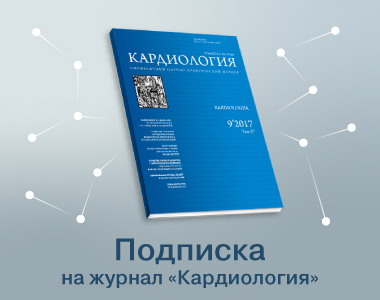Взаимосвязь маркеров клеточного старения с фибрилляцией предсердий
https://doi.org/10.18087/cardio.2025.8.n2914
Аннотация
Фибрилляция предсердий (ФП) – наиболее частая форма нарушений ритма сердца, распространенность которой повышается с возрастом. Замедление старения является одной из актуальных задач современной науки. Поэтому становится важным выявление лиц, имеющих маркеры преждевременного клеточного старения, для дальнейшей разработки фармакологических агентов, способных затормозить старение клеток. Мы предполагаем, что при ФП признаки клеточного старения появляются раньше, чем у лиц без ФП. Выполнены поиск, анализ и систематизация исследований взаимосвязи между маркерами клеточного старения в виде длины теломер лейкоцитов (ДТЛ) и уровня галектина-3 в плазме крови у пациентов с ФП. В большинстве проанализированных исследований уровень галектина-3 у пациентов с ФП был значительно выше, чем у практически здоровых лиц. ДТЛ лейкоцитов существенно не отличалась у пациентов с ФП и практически здоровых лиц. Соответственно, признаки клеточного старения у пациентов с ФП появляются раньше, чем у практически здоровых лиц. Дальнейшие клинические исследования маркеров клеточного старения у пациентов с ФП являются перспективным направлением в науке и требуют проведения крупных многоцентровых исследований с едиными дизайном и методологией исследования.
Ключевые слова
Об авторах
О. В. ЗимницкаяРоссия
Кандидат медицинских наук, врач-кардиолог Поликлиники №2
О. М. Драпкина
Россия
Доктор медицинских наук, профессор, академик РАН, директор
Список литературы
1. Обухова Н.Т., Агальцов М.В., Драпкина О.М. Сравнительная характеристика пациентов с сочетанием обструктивного апноэ сна и пароксизмальной формой фибрилляции предсердий в группах интервенционного и медикаментозного лечения аритмии. Российский кардиологический журнал. 2024;29(7):38-44]. DOI: 10.15829/1560-4071-2024-5777
2. Benjamin EJ, Virani SS, Callaway CW, Chamberlain AM, Chang AR, Cheng S et al. Heart Disease and Stroke Statistics – 2018 Update: A Report From the American Heart Association. Circulation. 2018;137(12):e67–492. DOI: 10.1161/CIR.0000000000000558
3. Schnabel RB, Yin X, Gona P, Larson MG, Beiser AS, McManus DD et al. 50 year trends in atrial fibrillation prevalence, incidence, risk factors, and mortality in the Framingham Heart Study: a cohort study. Lancet. 2015;386(9989):154–62. DOI: 10.1016/S0140-6736(14)61774-8
4. Казанова П.В., Басиева М.А., Шварц В.А. Иммунное ремоделирование в патогенезе фибрилляции предсердий. Анналы аритмологии. 2023;20(2):119-30]. DOI: 10.15275/annaritmol.2023.2.7
5. Василевич Н.И. Знать врага в лицо: молекулярные маркеры старения. Лаборатория и производство. 2020;13(3-4):118-28]. DOI: 10.32757/2619-0923.2020.3-4.13.118.128
6. Gupta K, Mathew AB, Chakrapani H, Saini DK. H2S contributed from CSE during cellular senescence suppresses inflammation and nitrosative stress. Biochimica et Biophysica Acta (BBA) -Molecular Cell Research. 2023;1870(2):119388. DOI: 10.1016/j.bbamcr.2022.119388
7. Raisi-Estabragh Z, Szabo L, Schuermans A, Salih AM, Chin CWL, Vágó H et al. Noninvasive Techniques for Tracking Biological Aging of the Cardiovascular System. JACC: Cardiovascular Imaging. 2024;17(5):533–51. DOI: 10.1016/j.jcmg.2024.03.001
8. Huang W, Hickson LJ, Eirin A, Kirkland JL, Lerman LO. Cellular senescence: the good, the bad and the unknown. Nature Reviews Nephrology. 2022;18(10):611–27. DOI: 10.1038/s41581-022-00601-z
9. Hamczyk MR, Nevado RM, Barettino A, Fuster V, Andrés V. Biological Versus Chronological Aging: JACC Focus Seminar. Journal of the American College of Cardiology. 2020;75(8):919–30. DOI: 10.1016/j.jacc.2019.11.062
10. Kieronska-Rudek A, Ascencao K, Chlopicki S, Szabo C. Increased hydrogen sulfide turnover serves a cytoprotective role during the development of replicative senescence. Biochemical Pharmacology. 2024;230(Pt 2):116595. DOI: 10.1016/j.bcp.2024.116595
11. Aubert G, Lansdorp PM. Telomeres and Aging. Physiological Reviews. 2008;88(2):557–79. DOI: 10.1152/physrev.00026.2007
12. Haycock PC, Heydon EE, Kaptoge S, Butterworth AS, Thompson A, Willeit P. Leucocyte telomere length and risk of cardiovascular disease: systematic review and meta-analysis. BMJ. 2014;349:g4227. DOI: 10.1136/bmj.g4227
13. Codd V, Wang Q, Allara E, Musicha C, Kaptoge S, Stoma S et al. Polygenic basis and biomedical consequences of telomere length variation. Nature Genetics. 2021;53(10):1425–33. DOI: 10.1038/s41588-021-00944-6
14. Procyk G, Czapla A, Jałocha K, Tymińska A, Grabowski M, Gąsecka A. The role of galectin-3 in atrial fibrillation. Journal of Molecular Medicine. 2023;101(12):1481–92. DOI: 10.1007/s00109-023-02378-5
15. Li N, Feng Q, Yu F, Zhou J, Guo X. Plasma growth differentiation factor- 15 in patients with “lone” atrial fibrillation. Journal of Clinical Laboratory Analysis. 2022;36(5):e24373. DOI: 10.1002/jcla.24373
16. Гизатулина Т.П., Хорькова Н.Ю., Мартьянова Л.У., Петелина Т.И., Зуева Е.В., Широков Н.Е. и др. Уровень ростового фактора дифференцировки 15 в качестве предиктора тромбоза левого предсердия у пациентов с неклапанной фибрилляцией предсердий. Кардиология. 2021;61(7):44-54]. DOI: 10.18087/cardio.2021.7.n1588
17. Jin X, Zhang Y, Zhou Y, Luo Y, Han X, Gao Y et al. Sirt1 Deficiency Promotes Age-Related AF Through Enhancing Atrial Necroptosis by Activation of RIPK1 Acetylation. Circulation: Arrhythmia and Electrophysiology. 2024;17(7):e012452. DOI: 10.1161/CIRCEP. 123.012452
18. Sun X, Bu P, Liu J, Wang X, Wu X, Zhao L. Expression of SIRT1 in right auricle tissues and the relationship with oxidative stress in patients with atrial fibrillation. Chinese Journal of Cellular and Molecular Immunology. 2012;28(9):972–4. PMID: 22980663
19. McClintock B. The Stability of Broken Ends of Chromosomes in Zea Mays. Genetics. 1941;26(2):234–82. DOI: 10.1093/genetics/26.2.234
20. Moyzis RK, Buckingham JM, Cram LS, Dani M, Deaven LL, Jones MD et al. A highly conserved repetitive DNA sequence, (TTAGGG)n, present at the telomeres of human chromosomes. Proceedings of the National Academy of Sciences. 1988;85(18):6622–6. DOI: 10.1073/pnas.85.18.6622
21. Rutherford Siegel S, Calcagni EA, Draughon KM, Logue SF. A Dual-Labeled Multiplex Absolute Telomere Length Method to Measure Average Telomere Length. DNA. 2024;4(4):370–9. DOI: 10.3390/dna4040026
22. Rubtsova M, Dontsova O. Human Telomerase RNA: Telomerase Component or More? Biomolecules. 2020;10(6):873. DOI: 10.3390/biom10060873
23. Zimnitskaya OV, Petrova MM, Lareva NV, Cherniaeva MS, Al-Zamil M, Ivanova AE et al. Leukocyte Telomere Length as a Molecular Biomarker of Coronary Heart Disease. Genes. 2022;13(7):1234. DOI: 10.3390/genes13071234
24. Arai Y, Martin-Ruiz CM, Takayama M, Abe Y, Takebayashi T, Koyasu S et al. Inflammation, But Not Telomere Length, Predicts Successful Ageing at Extreme Old Age: A Longitudinal Study of Semi-supercentenarians. EBioMedicine. 2015;2(10):1549–58. DOI: 10.1016/j. ebiom.2015.07.029
25. Brown LL, Zhang YS, Mitchell C, Ailshire J. Does Telomere Length Indicate Biological, Physical, and Cognitive Health Among Older Adults? Evidence from the Health and Retirement Study. The Journals of Gerontology: Series A. 2018;73(12):1626–32. DOI: 10.1093/gerona/gly001
26. Pusceddu I, Farrell C-JL, Di Pierro AM, Jani E, Herrmann W, Herrmann M. The role of telomeres and vitamin D in cellular aging and age-related diseases. Clinical Chemistry and Laboratory Medicine. 2015;53(11):1661–78. DOI: 10.1515/cclm-2014-1184
27. Allende M, Molina E, González-Porras JR, Toledo E, Lecumberri R, Hermida J. Short Leukocyte Telomere Length Is Associated With Cardioembolic Stroke Risk in Patients With Atrial Fibrillation. Stroke. 2016;47(3):863–5. DOI: 10.1161/STROKEAHA.115.011837
28. Sinner M, Kupka D, Wilfert W, Waldenberger M, Peters A, Holdt L et al. Telomere length is associated with atrial fibrillation. European Heart Journal. 2020;41(Suppl 2):ehaa946.0499. DOI: 10.1093/ehjci/ehaa946.0499
29. Sha Z, Hou T, Zhou T, Dai Y, Bao Y, Jin Q et al. Causal relationship between atrial fibrillation and leukocyte telomere length: A two sample, bidirectional Mendelian randomization study. Frontiers in Cardiovascular Medicine. 2023;10:1093255. DOI: 10.3389/fcvm.2023.1093255
30. Zheng Y, Zhang N, Wang Y, Wang F, Li G, Tse G et al. Association between leucocyte telomere length and the risk of atrial fibrillation: An updated systematic review and meta-analysis. Ageing Research Reviews. 2022;81:101707. DOI: 10.1016/j.arr.2022.101707
31. Siland JE, Geelhoed B, Van Gelder IC, Van Der Harst P, Rienstra M. Telomere length and incident atrial fibrillation – data of the PREVEND cohort. PLOS ONE. 2017;12(2):e0171545. DOI: 10.1371/journal.pone.0171545
32. Sanchis-Gomar F, Santos-Lozano A, Pareja-Galeano H, Garatachea N, Alis R, Fiuza-Luces C et al. Galectin-3, osteopontin and successful aging. Clinical Chemistry and Laboratory Medicine. 2016;54(5):873–7. DOI: 10.1515/cclm-2015-0821
33. Gong M, Cheung A, Wang Q, Li G, Goudis CA, Bazoukis G et al. Galectin-3 and risk of atrial fibrillation: A systematic review and metaanalysis. Journal of Clinical Laboratory Analysis. 2020;34(3):e23104. DOI: 10.1002/jcla.23104
34. Blanda V, Bracale UM, Di Taranto MD, Fortunato G. Galectin-3 in Cardiovascular Diseases. International Journal of Molecular Sciences. 2020;21(23):9232. DOI: 10.3390/ijms21239232
35. Scarabino D, Broggio E, Gambina G, Corbo RM. Leukocyte telomere length in mild cognitive impairment and Alzheimer’s disease patients. Experimental Gerontology. 2017;98:143–7. DOI: 10.1016/j.exger.2017.08.025
36. Liu M, Huo YR, Wang J, Wang C, Liu S, Liu S et al. Telomere Shortening in Alzheimer’s Disease Patients. Annals of Clinical and Laboratory Science. 2016;46(3):260–5. PMID: 27312549
37. Sindi S, Solomon A, Kåreholt I, Hovatta I, Antikainen R, Hänninen T et al. Telomere Length Change in a Multidomain Lifestyle Intervention to Prevent Cognitive Decline: A Randomized Clinical Trial. The Journals of Gerontology: Series A. 2021;76(3):491–8. DOI: 10.1093/gerona/glaa279
38. Wang S, Gao Y, Zhao L, Hu R, Yang X, Liu Y. Shortened leukocyte telomere length as a potential biomarker for predicting the progression of atrial fibrillation from paroxysm to persistence in the short-term. Medicine. 2021;100(23):e26020. DOI: 10.1097/MD.0000000000026020
39. Zhang D, Wen X, Zhang L, Cui W. DNA Methylation of Human Telomerase Reverse Transcriptase Associated With Leukocyte Telomere Length Shortening in Hyperhomocysteinemia-Type Hypertension in Humans and in a Rat Model. Circulation Journal. 2014;78(8):1915–23. DOI: 10.1253/circj.CJ-14-0233
40. Chen C, Upton C, Braidy N, Khalil J, Fang Z, Xu Y et al. Association Between Leukocyte Telomere Length and Vascular Dementia and Cancer Mortality in an Elderly Population. Journal of the American Geriatrics Society. 2014;62(7):1384–6. DOI: 10.1111/jgs.12910
41. Tempaku PF, Mazzotti DR, Hirotsu C, Andersen ML, Xavier G, Maurya PK et al. The effect of the severity of obstructive sleep apnea syndrome on telomere length. Oncotarget. 2016;7(43):69216–24. DOI: 10.18632/oncotarget.12293
42. Hinterberger M, Fischer P, Huber K, Krugluger W, Zehetmayer S. Leukocyte telomere length is linked to vascular risk factors not to Alzheimer’s disease in the VITA study. Journal of Neural Transmission. 2017;124(7):809–19. DOI: 10.1007/s00702-017-1721-z
43. Pan K-L, Hsiao Y-W, Lin Y-J, Lo L-W, Hu Y-F, Chung F-P et al. Shorter Leukocyte Telomere Length Is Associated With Atrial Remodeling and Predicts Recurrence in Younger Patients With Paroxysmal Atrial Fibrillation After Radiofrequency Ablation. Circulation Journal. 2019;83(7):1449–55. DOI: 10.1253/circj.CJ-18-0880
44. Kim E-J, Koh S-H, Ha J, Na DL, Seo SW, Kim H-J et al. Increased telomere length in patients with frontotemporal dementia syndrome. Journal of the Neurological Sciences. 2021;428:117565. DOI: 10.1016/j.jns.2021.117565
45. Wang Q, Liu Z, Dong Y, Yang X, Chen M, Gao Y. Leukocyte Telomere Length Predicts Progression From Paroxysmal to Persistent Atrial Fibrillation in the Long Term After Catheter Ablation. Frontiers in Cardiovascular Medicine. 2022;8:813390. DOI: 10.3389/fcvm.2021.813390
46. Roberts JD, Dewland TA, Longoria J, Fitzpatrick AL, Ziv E, Hu D et al. Telomere Length and the Risk of Atrial Fibrillation: Insights Into the Role of Biological Versus Chronological Aging. Circulation: Arrhythmia and Electrophysiology. 2014;7(6):1026–32. DOI: 10.1161/CIRCEP.114.001781
47. Djoussé L, Matsumoto C, Petrone A, Weir NL, Tsai MY, Gaziano JM. Plasma galectin 3 and heart failure risk in the Physicians’ Health Study. European Journal of Heart Failure. 2014;16(3):350–4. DOI: 10.1002/ejhf.21
48. Wu X-Y, Li S-N, Wen S-N, Nie J-G, Deng W-N, Bai R et al. Plasma galectin-3 predicts clinical outcomes after catheter ablation in persistent atrial fibrillation patients without structural heart disease. Europace. 2015;17(10):1541–7. DOI: 10.1093/europace/euv045
49. Issa SF, Christensen AF, Lottenburger T, Junker K, Lindegaard H, Hørslev-Petersen K et al. Within-day variation and influence of physical exercise on circulating Galectin-3 in patients with rheumatoid arthritis and healthy individuals. Scandinavian Journal of Immunology. 2015;82(1):70–5. DOI: 10.1111/sji.12301
50. Kornej J, Schmidl J, Ueberham L, John S, Daneschnejad S, Dinov B et al. Galectin-3 in Patients with Atrial Fibrillation Undergoing Radiofrequency Catheter Ablation. PLOS ONE. 2015;10(4):e0123574. DOI: 10.1371/journal.pone.0123574
51. Pavlović M, Apostolović S, Stokanović D, Momčilović S, Jevtović-Stoimenov T, Zdravković SĆ et al. The Association between Galectin-3 and hs-CRP and the Clinical Outcome after Non-ST-Elevation Myocardial Infarction with Preexisting Atrial Fibrillation. Scientific Reports. 2017;7(1):15106. DOI: 10.1038/s41598-017-15265-0
52. Clementy N, Benhenda N, Piver E, Pierre B, Bernard A, Fauchier L et al. Serum Galectin-3 Levels Predict Recurrences after Ablation of Atrial Fibrillation. Scientific Reports. 2016;6(1):34357. DOI: 10.1038/srep34357
53. Kisheva A, Yotov Y, Chervenkov T, Angelov A, Bocheva Y. Galectin-3 in patients with atrial fibrillation and restored sinus rhythm. Folia Medica. 2021;63(3):329–36. DOI: 10.3897/folmed.63.e55313
Рецензия
Для цитирования:
Зимницкая О.В., Драпкина О.М. Взаимосвязь маркеров клеточного старения с фибрилляцией предсердий. Кардиология. 2025;65(8):82-88. https://doi.org/10.18087/cardio.2025.8.n2914
For citation:
Zimnitskaya O.V., Drapkina O.M. The Relationship of Markers of Cellular Aging with Atrial Fibrillation. Kardiologiia. 2025;65(8):82-88. (In Russ.) https://doi.org/10.18087/cardio.2025.8.n2914

















